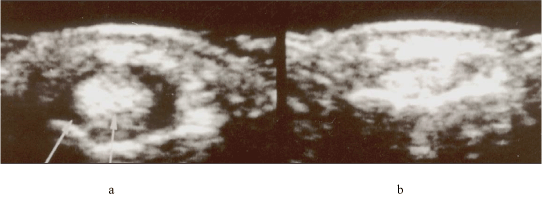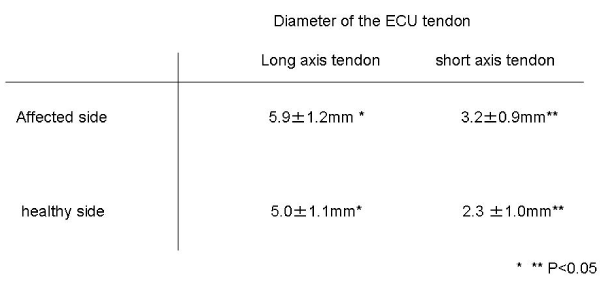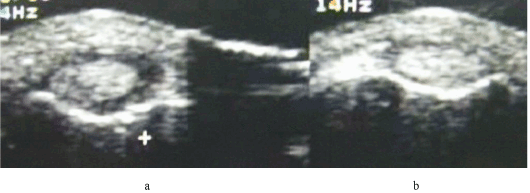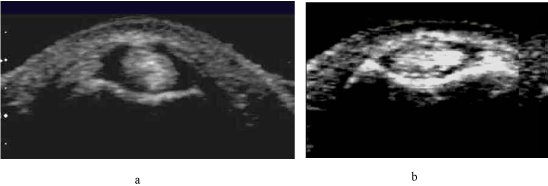Case Report Open Access
Ultrasonographic Diagnosis for Tenosynovitis of Extensor Carpi Ulnaris
| Hiroyuki Shimizu*, Moroe Beppu, Takeshi Arai, Toshihito Naito and Masahiro Tanaka | |
| Department of Orthopaedic Surgery, St. Marianna University School of Medicine, Kawasaki, Japan | |
| Corresponding Author : | Hiroyuki Shimizu Department of Orthopaedic Surgery St. Marianna University School of Medicine 2-16-1 Sugao, Miyamae-ku, Kawasaki, Kanagawa 211-8511, Japan Tel: +81-44-044-977-8111 Fax: +81-44-044-977-9651 E-mail: h3simizu@marianna-u.ac.jp |
| Received December 18, 2013; Accepted January 04, 2014; Published January 10, 2014 | |
| Citation: Shimizu H, Beppu M, Arai T, Naito T, Tanaka M (2014) Ultrasonographic Diagnosis for Tenosynovitis of Extensor Carpi Ulnaris. OMICS J Radiol 3:157. doi: 10.4172/2167-7964.1000157 | |
| Copyright: © 2014 Shimizu H, et al. This is an open-access article distributed under the terms of the Creative Commons Attribution License, which permits unrestricted use, distribution, and reproduction in any medium, provided the original author and source are credited. | |
Visit for more related articles at Journal of Radiology
Abstract
We investigated the usefulness of ultrasound imaging and treatments for tenosynovitis of the extensor carpi ulnaris (ECU), based on clinical findings. Ultrasonography for diagnostic imaging of ECU tenosynovitis has not been previously reported. This study included 29 patients who were diagnosed as having ECU tendinitis and underwent ultrasonography. The short-axis view ultrasound images were characterized by an oval hyperechoic area in the ECU tendon from the distal to the peripheral end of the ulna on the affected side in all patients and a hypoechoic area suggesting a thickened synovial membrane of the tendon sheath around the ECU tendon. Patients with the most pronounced findings showed the greatest resistance to conservative therapy. Ultrasound images can be an indicator for differentiating ECU tendinitis from other diseases and determining therapeutic strategies. In cases with ulnar-sided wrist pain without these characteristic ultrasound imaging findings, injury of the triangular fibro cartilage complex should be suspected.
| Keywords |
| Tenosynovitis; Ultrasonography; Extensor carpi ulnaris; Sixth dorsal compartment of wrist |
| Introduction |
| Tenosynovitis of the extensor carpi ulnaris (ECU) is not common in cases with ulnar-sided wrist pain but should be differentiated from rheumatoid synovitis, disorders of the triangular fibrocartilage complex (TFCC), and other diseases [1]. |
| The ECU tendon runs in the tendon groove on the ulnar head and has a double structure composed of the extensor tendon retinaculum and proper tendon sheath, which is a membrane-like structure of the layer under the retinaculum. This proper tendon sheath was termed the fibro-osseous canal by Spinner et al. [2], and the ECU subsheath by Palmer et al. [3]. Moreover, the orientation angle of the ECU tendon decreases with the ulna plus variant and becomes sharp, especially with pronation and supination of the forearm. Thus, the tendon has an anatomical structure that is likely to cause mechanical tenosynovitis [4]. |
| In this study, we examined features observed on ultrasound images, clinical findings, and therapeutic strategies in patients with ECU tenosynovitis suspected at the initial visit or during the course of treatment. All subjects underwent ultrasonography. We report on the usefulness of ultrasound imaging for diagnosis. |
| Materials and Methods |
| This study included 29 patients (11 men and 18 women; affected side: right in 19 patients and left in 10) with ECU tenosynovitis suspected at the initial visit or during the course of treatment who underwent ultrasonography. The mean age was 44 years (range: 26-75 years). ECU tenosynovitis was induced by overuse in 18 patients and by other factors in 11. Short-axis view ultrasound images around the groove on the ulnar head were obtained to observe the conditions of the ECU tendon itself and its surrounding area. Furthermore, the long and short diameters of the ECU tendon were measured on the affected and healthy sides in 15 patients. The statistical significance level was p ≤ 0.05. A 10-MHz mechanical sector probe was used, and ultrasound features were compared with clinical findings and courses. |
| Results |
| Tenderness along the ECU tendon was detected in all patients, and swelling around the tendon was observed in 20. The ECU Tenosynovitis Test, a manual pain provocation test, was positive in 26 patients. Posteroanterior radiography of the wrist revealed ulna plus variant in 15 patients, ulna minus variant in 8, and ulna zero variant in 6. |
| On the affected side, the short-axis view ultrasound images were characterized by an oval hyperechoic area in the ECU tendon from the distal to the peripheral end of the ulna and a hypoechoic area suggesting a thickened synovial membrane of the tendon sheath around the ECU tendon in all patients (Figure 1a). On the other hand, the ECU tendon on the healthy side was defined as a linear, flat, hyperechoic area, as compared to that on the affected side, and no hypoechoic area was observed around the ECU tendon (Figure 1b). On the short-axis view ultrasound images, the long and short diameters of the ECU tendon were significantly greater on the affected than on the healthy side (Figure 2). |
| Symptoms were relieved by topical agents alone in 3 patients, external fixation and topical agents in 4, and external fixation, topical agents, and tendon sheath steroid injections (mean: 3 times) in 18. Four patients did not respond to 6 months of conservative therapy and underwent surgery (tendon sheath incision). |
| On the short-axis view ultrasound images, the oval hyperechoic area in the ECU tendon was larger in patients undergoing surgery than in those responding to conservative therapy. |
| Moreover, among patients who had findings of ECU tendinitis on short-axis view ultrasound images, 3 were diagnosed as having a combination of TFCC injury and ECU tendinitis by arthroscopy, 4 were diagnosed as having only TFCC injury. |
| Cases |
| Case 1: A 32-year old male photographer visited our hospital for left ulnar-sided wrist pain. The patient had tenderness and swelling along the ECU tendon and the ECU Tenosynovitis Test was positive. While the ECU tendon on the affected side was thicker than that on the healthy side on ultrasound images, the characteristic findings of an oval hyperechoic area in the ECU tendon and a hypoechoic area around the tendon were both demonstrated (Figure 3). Because the patient did not respond to 6 months of conservative therapy, incision of the ECU tendon sheath was performed. The intraoperative findings revealed stenosis of the ECU tendon and a thickened ECU tendon at the distal end. Thus, Z-plasty of the extensor retinaculum for prevention of the ECU tendon dislocation was additionally performed. Pain had disappeared 2 months after surgery. |
| Case 2: A 30-year-old female nurse at our hospital was examined for left ulnar-sided wrist pain. The patient had tenderness and swelling along the ECU tendon and the ECU Tenosynovitis Test was positive. Ultrasonography revealed the characteristic findings of an oval hyperechoic area in the ECU tendon and a hypoechoic area around the tendon (Figure 4). Treatment with topical agents, a prosthesis, and 6 steroid injections relieved pain in 10 months. |
| Case 3: A 41-year-old man visited our hospital for left ulnar-sided wrist pain. The patient had tenderness along the ECU tendon and the ECU Tenosynovitis Test and the ulnocarpal stress test were both positive. The ultrasound images revealed the characteristic findings of ECU tenosynovitis. Because the ulnocarpal stress test result did not become negative despite steroid injection into the ECU tendon, the efficacy of local anesthetics for the TFCC was assessed. Because wrist arthroscopy revealed a Palmer class 1A lesion [5] of the TFCC, debridement of the TFCC and incision of the ECU tendon sheath were performed. Symptoms had disappeared 2 months after surgery. Thus, he was assumed to have had a combination of TFCC injury and ECU tendinitis. |
| Discussion |
| ECU tenosynovitis inevitably causes tenderness along the tendon, showing high positive rates on ECU tendon pain provocation tests represented by the prayer’s hand/supination test and active-resistive extension/ulnar flexion test. Because these manual tests require movement of the wrist joints which imposes a load on the TFCC, it may be difficult to exclude intraarticular lesions of the TFCC and similar disorders. The ECU synergy test [6], which was reported by Ruland and Hogan in 2008, places no load on the intraarticular structures, such as the TFCC. Thus, this test is considered to be an ECU tendon pain provocation test with a high positive rate that can exclude intraarticular lesions. The ECU synergy test is performed by having the patient rest with the elbow flexed 90° and the forearm in full supination. Facing the patient, the examiner grasps the patient’s thumb and long finger with one hand and palpates the ECU tendon with the other hand. The patient then radially abducts the thumb against resistance. Re-creation of pain along the dorsal ulnar aspect of the wrist is considered to be a positive test for ECU tendonitis [6]. |
| ECU tenosynovitis is diagnosed when 3 or more of the following 5 diagnostic criteria are met: 1) tenderness of the ECU tendon, 2) swelling of the ECU tendon, 3) pain induced by forced supination of the forearm, 4) ulna plus variant on radiography, and 5) response to steroid injection [1,4,7]. Moreover, the diagnosis of ECU tenosynovitis requires 3 or more of the following 5 criteria to be met: 1) tenderness of the ECU tendon, 2) swelling of the ECU tendon, 3) positive prayer’s hand/supination test, 4) positive active-resistive extension/ulnar flexion test, and 5) complete response to steroid injection. Furthermore, ECU tenosynovitis should be differentiated from TFCC injury by excluding the following items: 1) positive ulnocarpal stress test, 2) absence of click during pronation/supination, 3) abnormal shadow of the lunate/ triquetrum bone on radiography, and 4) abnormal findings on imaging studies, such as arthrography and magnetic resonance imaging (MRI) [1,4,7]. |
| The important points for differentiating ulnar-sided wrist pain associated with ECU tendinitis from other disorders are to exclude intraarticular lesions, such as TFCC injury, and to correctly identify combined TFCC injury and ECU tendinitis. Because there are occasional reports on the combination of ECU tendinitis and TFCC injury, including one of our cases, the diagnosis of ECU tendinitis can be confirmed if the following conditions are present: 1) tenderness and swelling in the ulnar-sided wrist region, 2) a positive result on the ECU synergy test, 3) increases in the oval hyperechoic area in the ECU tendon and a hypoechoic area around the tendon, and 4) ECU response to steroids. If a patient has a positive ulnocarpal stress test, TFCC injury should be suspected. After the efficacy of local anesthetics on the TFCC is confirmed, MRI of the wrist should be performed. If a patient is positive for both manual tests of ECU tendon pain provocation and ulnocarpal stress tests and has findings of ECU tendinitis based on ultrasound images, steroids should be injected into the ECU tendon. If there is no pain relief, MRI should be performed to determine whether ECU tendinitis is associated with TFCC injury and whether there is synovitis due to rheumatoid arthritis. In comparison with MRI, the most useful aspects of ultrasonography for diagnostic imaging of ECU tenosynovitis are that moving images can be obtained, the technique is inexpensive and simple, and the affected and healthy sides can be compared. Ultrasonography for diagnostic imaging of ECU tenosynovitis, to our knowledge,has not been previously reported. |
| In conclusion, tenderness along the ECU tendon must be present to make a diagnosis of ECU tendinitis. The characteristic ultrasonographic features include an increase in the oval hyperechoic area in the ECU tendon and a hypoechoic area around the tendon. As these findings become more pronounced, patients become increasingly resistant to conservative therapy. Ultrasound imaging findings can be an indicator allowing differentiation of ECU tendinitis from other diseases and determining therapeutic strategies. In cases with ulnar-sided wrist pain without the characteristic ultrasound imaging findings of ECU tendinitis, TFCC injury or other disorders should be suspected rather than ECU tenosynovitis. |
References |
|
Figures at a glance
 |
 |
 |
 |
| Figure 1 | Figure 2 | Figure 3 | Figure 4 |
Relevant Topics
- Abdominal Radiology
- AI in Radiology
- Breast Imaging
- Cardiovascular Radiology
- Chest Radiology
- Clinical Radiology
- CT Imaging
- Diagnostic Radiology
- Emergency Radiology
- Fluoroscopy Radiology
- General Radiology
- Genitourinary Radiology
- Interventional Radiology Techniques
- Mammography
- Minimal Invasive surgery
- Musculoskeletal Radiology
- Neuroradiology
- Neuroradiology Advances
- Oral and Maxillofacial Radiology
- Radiography
- Radiology Imaging
- Surgical Radiology
- Tele Radiology
- Therapeutic Radiology
Recommended Journals
Article Tools
Article Usage
- Total views: 17081
- [From(publication date):
April-2014 - Mar 29, 2025] - Breakdown by view type
- HTML page views : 12448
- PDF downloads : 4633
